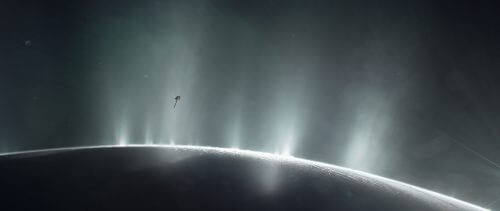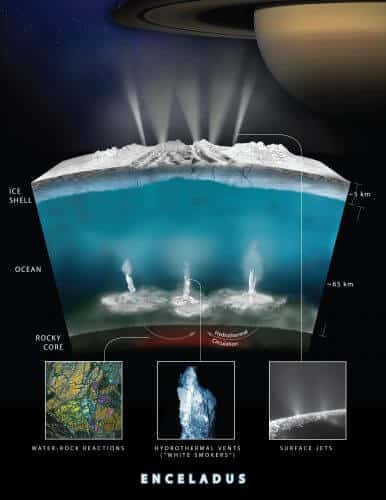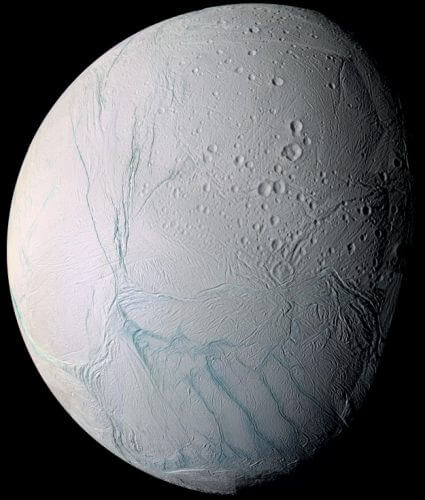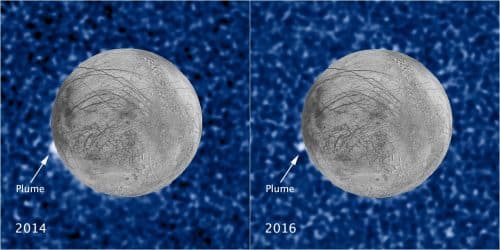Two new discoveries, which NASA revealed yesterday at a special press conference, strengthen the possibility that the mysterious oceans, hidden under the ice of the moons of Jupiter and Saturn, may be suitable for the existence of extraterrestrial life.

The main discovery that NASA revealed was made by the Cassini spacecraft, in which molecular hydrogen was identified for the first time in the jets of water bursting into space from the sub-icy ocean of Enceladus, one of Saturn's moons. The hydrogen may be used as a food source for bacteria in hot water outflows at the bottom of the ocean, similar to the phenomenon that exists on Earth. At the same time, it was revealed that the Hubble Space Telescope was again able to observe jets of water erupting from Europa, a moon of Jupiter, where researchers also estimate that there is a sub-ice ocean.
"Enceladus' ocean is like a candy store for bacteria"
The American space agency revealed that the Cassini spacecraft discovered hydrogen molecules (H2) in the jets of water that erupt from cracks in the moon, and originate in its subglacial ocean. The hydrogen, which the researchers estimate was created inhydrothermal vents of warm water on the ocean floor, may be an important food source for living organisms, which may, similar to methanogenic bacteria on Earth, feed on hydrogen and carbon dioxide (and create methane as a byproduct).
Cassini has so far made many discoveries of the fascinating system of moons and rings around the gas giant Saturn, and one of the main ones is the sub-icy ocean of the moon Enceladus. This was one of the spacecraft's first discoveries, just a year after it entered orbit around Saturn in 2004. Enceladus is an extremely small moon, with a diameter of only 500 km, and the researchers did not expect it to be geologically active, but the probe's photographs showed that at its south pole there are hot cracks from which jets of water erupt. The researchers estimate that the jets originate from a global ocean beneath the outer ice layer, and that its existence is made possible thanks to the tidal forces that Jupiter creates on the moon, which cause friction and heat in the moon's depths.
The water jets allowed the spacecraft to directly sample the composition of the mysterious ocean. Although the spacecraft's instrumentation was not originally built for such a mission, Cassini was able to use its mass spectrometer (INMS), to determine that the jets consist of 98% water, and residuals of carbon dioxide, methane and ammonia.

The new study, which was published in the journal Science, is based on mass spectrometer data during the nearest fly of the spacecraft around the moon on October 28, 2015, in which it reached a distance of only 48 km from its surface, passed right inside the water jets and sampled them directly. The daring flight allowed the spacecraft to detect molecular hydrogen (H2) in the jets, and determine that it constitutes between 0.4 and 1.4 percent of their composition.
The researchers estimate that the most plausible explanation is that the discovered hydrogen was created by hydrothermal vents on the ocean floor of Enceladus - water that heats up inside the moon's rocky core and erupts as underwater geysers. On Earth, the energy and chemical reactions in hydrothermal vents at the bottom of the oceans are a substitute for sunlight, and enable the existence of extensive ecosystems in the depths. There are researchers who Raise the possibility Because hydrothermal vents were the primary source of life on Earth.
The discovery of the hydrogen not only strengthens the hypothesis that hydrothermal vents do exist on the ocean floor of Enceladus, but it points to the existence of a food source for living creatures on the moon, if they even exist there. On Earth, bacteria in hydrothermal vents feed on hydrogen and carbon dioxide, in a process known as methanogenesis (methanogenesis), where methane is formed as a byproduct.
According to NASA researchers, the discovery strengthens the possibility of the existence of a life-supporting environment on the moon, although they emphasized that the Cassini spacecraft is not able to detect life directly and the study does not indicate direct or indirect evidence of the existence of extraterrestrial life on the moon.

"Even though we didn't discover life, we found that there was a food source for them. It's like a candy store for bacteria," said Hunter White, lead author of the study.
According to NASA, it is possible to assess the level of support of any environment for the existence of life (as we know it on Earth) according to three categories - liquid water, an energy source that enables metabolism and an appropriate chemical composition. As mentioned, the discovered hydrogen can serve as an important source of energy for living beings. The new discovery adds hydrogen to the list of chemical elements essential to life that have been definitely discovered on Enceladus, along with carbon, nitrogen and oxygen. Phosphorus and sulfur, which are also essential for life, have not been discovered directly, but the researchers estimate that they exist in the rocky core of the moon.
Water jets have again been observed on Jupiter's moon Europa
At the same time as the discovery of hydrogen in Enceladus, NASA revealed that the Hubble Space Telescope was able to observe again jets of water erupting from Saturn's moon Europa, where researchers also estimate that there is a sub-ice ocean. The sighting was reported In an article in The Astrophysical Journal Letters.
Unlike Saturn's moon Anselus, whose water jets erupt regularly and are clearly visible in Cassini's upcoming observations, the existence of Europa's presumed water jets is still uncertain.

The Galileo spacecraft, which studied Jupiter and its moons between 1995 and 2003, discovered Europa's subglacial ocean, but did so indirectly through its magnetometer data. The spacecraft did not detect water jets on the moon - but it was not designed to look for such phenomena at all, what's more, its scientific equipment was quite outdated and based on technology from the 70s.
After Cassini discovered water jets in Enceladus, NASA researchers wanted to know if the phenomenon also exists in Europe. The researchers used the Hubble Space Telescope's ultraviolet observation capability to try to identify the water jets.
The observations have so far yielded a number of images showing signs that may be the sought-after jets of water, although researchers are still not entirely sure, as the observations stretched the space telescope's capabilities to the limit.
The new observation was made in 2016, and its importance stems from the fact that the supposed jet of water observed by Hubble erupts in exactly the same area of the moon where a similar jet was detected in 2014. This region of the moon was previously observed closely by the Galileo spacecraft, which discovered that it is hotter than its surroundings. In addition, the two observations were made from different angles by Hubble, so the researchers could rule out the possibility that the source of the observation was due to some problem with the telescope. All these together greatly strengthen the hypothesis of the researchers that it is indeed a jet of water breaking through the outer ice layer of the moon.

Although the two new discoveries do not make it possible to determine whether life really exists on those distant worlds, they strengthen the possibility that their environment could be suitable for life. NASA is currently developing the "Clipper" spaceship for the exploration of the moon Europa, which will be launched in the first half of the next decade. If water jets do exist on Europa, they would allow the spacecraft to directly sample the composition of its subglacial ocean. The discovery of hydrogen on Enceladus strengthens the possibility of a life-supporting environment on the moon and advances the possibility of a possible follow-up mission to Cassini, which will end its life this year Diving into Jupiter's atmosphere. Such a task may be selected in the framework The competition for the next task in the "New Frontiers" program of NASA, which opens this year. The winner of the competition will be chosen in 2019 and will probably be launched in 2025.
See more on the subject on the science website:
